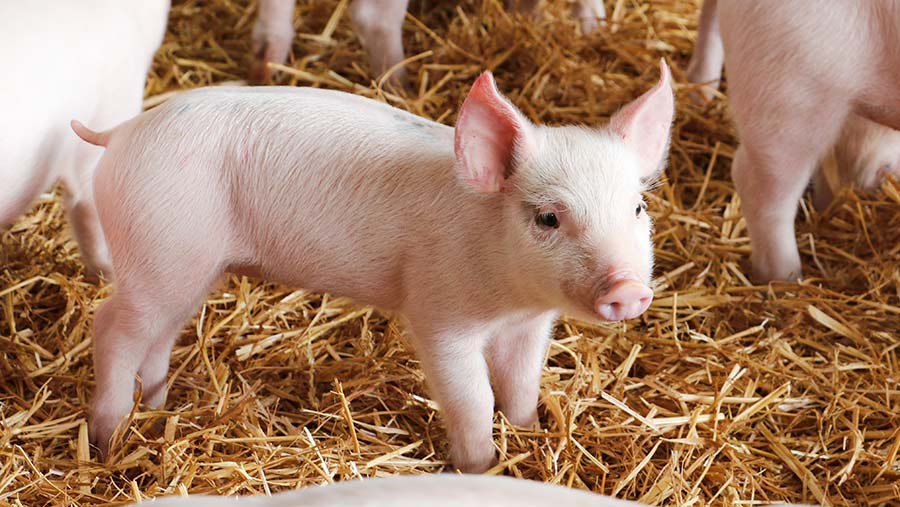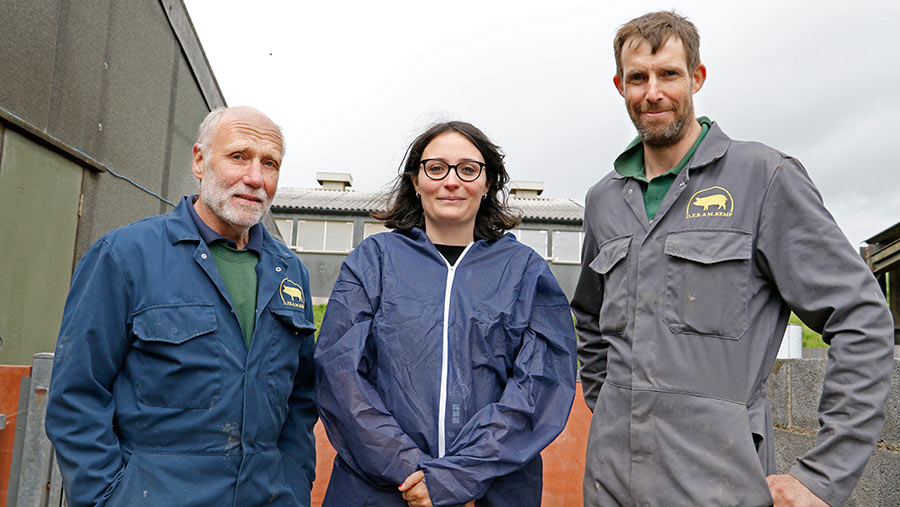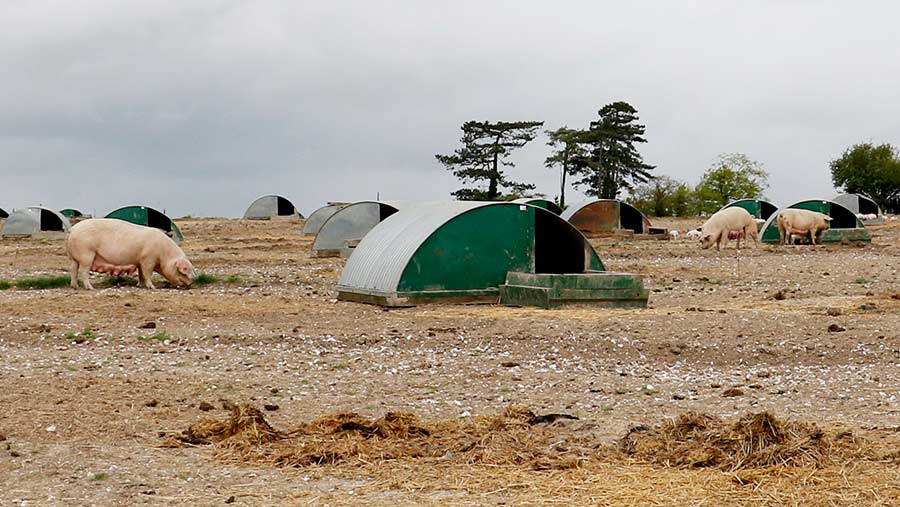How a pig farmer has overcome salmonella infection in weaner piglets
 Salmonella is no longer a problem in the farm’s weaned piglets
Salmonella is no longer a problem in the farm’s weaned piglets Pig farmer David Kemp has managed to beat a nasty outbreak of salmonella, in the process cutting antibiotics use to less than 1mg/kg.
Mr Kemp, who runs a farrow-to-finishing enterprise in Salisbury, Wiltshire, first observed clinical salmonella in weaner piglets in 2016. Treatment was proving ineffective so he had to consider changing tack.
At that time, there wasn’t a licensed vaccine for salmonella typhimurium (ST) in the UK, so Mr Kemp obtained one under special licence through his vet and became part of a Defra-supported study partly funded by the vaccine manufacturer IDT Biologika.
Farm facts
- 500 Duroc x Landrace sows
- 38ha
- Farrowing outdoors, with dry sows in straw yards
- Weaners, growers and finishers housed indoors. Growing pigs taken to 50-60kg. They then move on to a liquid feed diet and are sold averaging 105kg
- Supplies Tulip
- Buys gilts from Rattlerow Farms
- Using AI sires from PIC
- Piglets vaccinated for enzootic pneumonia and circovirus
- Sows vaccinated for erysipelas, parvovirus, salmonella and clostridial disease.
Antibiotic use was already low on the unit, but since vaccinating and improving cleanliness, he has reduced use from nearly 1mg/kg to zero for the last two quarters of 2018 (see graphic).
Together with Mr Kemp, Apha vet Dr Francesca Martelli and Mr Kemp’s vet, Julia James, of Larkmead Vets, explain how vaccination and improved cleanliness have reduced disease prevalence and further minimised antibiotic use.
About the salmonella issue
For the first 14 days after weaning Mr Kemp had been using in-feed medication to treat weaners, but he couldn’t seem to get rid of the infection.
He says piglets were succumbing to the intestinal disease 3-4 weeks after weaning and mortality was peaking at 10% in some batches.
The prevalence of ST was lower in finishing pigs than younger animals, with the use of an acidic liquid feed for older animals contributing to this.
This type of feed promotes more acidic conditions (lower pH) in the intestinal tract, making the environment inhospitable for salmonella as well as promoting the proliferation of other bacteria, such as lactobacilli, which can competitively exclude salmonella.
But acidifying the water was a challenge in the weaning accommodation, and it is not as effective as acidic liquid feeding.
Mr Kemp met Dr Martelli at a National Pig Association (NPA) event, and she visited the farm in 2016, funded by Defra, taking faeces samples to identify the salmonella strain and its distribution on the farm.
Tests revealed that the pathogen was salmonella typhimurium, which causes clinical disease such as scour and wasting in young pigs, in particular.

David Kemp (left) with Apha vet Dr Francesca Martelli and farm worker Tim Storer
Treating the infection with antibiotics is not always advisable and the reason Mr Kemp’s treatment had proved ineffective was because the strain had become resistant to the antibiotics being administered, Dr Martelli explains, so in-feed medication was stopped immediately.
Instead, Dr Martelli devised a plan of action to get on top of the outbreak, in conjunction with Mr Kemp’s vet.
Vaccination
Vaccination has played a vital part in reducing disease prevalence. In October 2017 the farm began vaccinating sows and piglets with a live, attenuated vaccine called Salmoporc STM.
The vaccine was provided free by IDT Biologika in Germany, which needed to collect efficacy data for the UK in order to get the product licensed here.
It is administered subcutaneously to sows and orally to piglets.
- Piglets were vaccinated at four days and four weeks of age over a 12-month period.
- Sows were given an initial two doses six weeks apart, with a booster given three weeks before farrowing.
- Gilts were vaccinated as they were introduced to the herd.
Disinfection
Improved disinfection has also been critical.
The disinfectant Mr Kemp was using wasn’t effective on the farm. Buildings are not purpose-built pig sheds; weaners are housed in converted calf sheds and it is difficult to achieve very clean conditions prior to applying the disinfectant.
Weaners are littered on deep straw with pens cleaned out weekly between batches. This makes it hard to maintain a clean environment and turnaround is fast, with a new batch of piglets arriving the day after cleanout.
The solution was to change the class of disinfectant to one that was more effective on the farm.
Testing
As part of the study, Dr Martelli and Apha colleagues visited the farm every six months and sampled pig faeces for ST.
An ongoing, second project, funded by the Veterinary Medicines Directorate (VMD), is investigating microbiological changes on the unit following the reduced use of antimicrobials being administered.
As part of this study, faeces samples are also tested for E.coli – a species of intestinal bacteria which can cause infections in animals and humans, although pigs are not considered to be a source of human infection in the way that can occur with ST.
E.coli is scientifically recognised as the best indicator organism for antimicrobial resistance in gram-negative bacteria.
About 500 faeces samples from all classes of pigs are collected at any one time, which takes 3-4 people 6-7 hours. Samples are pooled and then taken back to the lab for testing.
Results
Clinical symptoms of ST have subsided and sampling shows the prevalence of salmonella in the environment has declined on farm over the duration of the study.
After 12 months of vaccinating piglets, it has been deemed safe enough for Mr Kemp to vaccinate only sows and gilts.
Mr Kemp has continued to vaccinate the herd following the end of the trial, and the vaccine is still being imported under special licence, but IDT Biologika hopes to launch it to the UK market this autumn and UK prices will then become available.
Very little resistance was found to critically important antibiotics for medical treatment, but there was some resistance to ampicillin and trimethoprim, both on the on World Health Organization’s List of Essential Medicines for human use.

Preliminary results show a 23.2 percentage point decline in the proportion of E.coli bacteria that were resistant to ampicillin (from 50.9% to 27.7%) and a 26.5-point decline in resistance to trimethoprim (from 45% to 18.5%).
Antibiotics are still used on the farm when needed, but only on a case-by-case basis.
Mr Kemp says he was taught at Reading Agricultural college decades ago about antibiotic resistance, and it is one of the reasons he has always been stringent in their use; only ever using in-feed medication in the weaners.
He says: “As far as I’m concerned if you have to use antibiotics to survive you are doing something wrong. It puzzles me why it has taken this long to get it up the agenda.”
Tips for controlling salmonella on your farm
- Rotate outdoor herds every two years to rest fields and reduce build-up of bacteria.
- Use a disinfectant that is Defra approved and use it at the dilution rate shown on the General Orders list. Manufacturers must pay to get their products tested to be on this list, and to pass certification the disinfectant must give a 99.999% reduction of the test organism.
- Check incoming stock and ask your supplier if they are testing or vaccinating for salmonella.
- Control pests on your farm. They can carry and amplify infection, so a good pest control programme is key.
- Allow piglets to run together before weaning and then maintain stable groups thereafter, without further mixing of pigs.
- Speak to your vet about vaccination.
- Get testing done and identify the strain.
- Ask your vet to carry out sensitivity testing to see if antibiotics are working properly and check that you are not building up resistance.
Source: Dr Francesca Martelli
